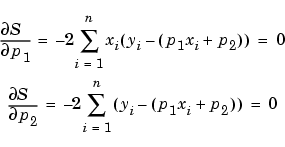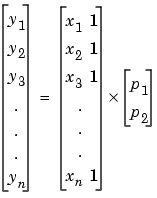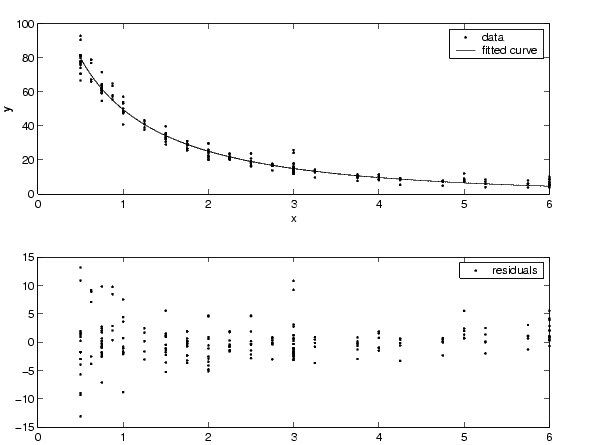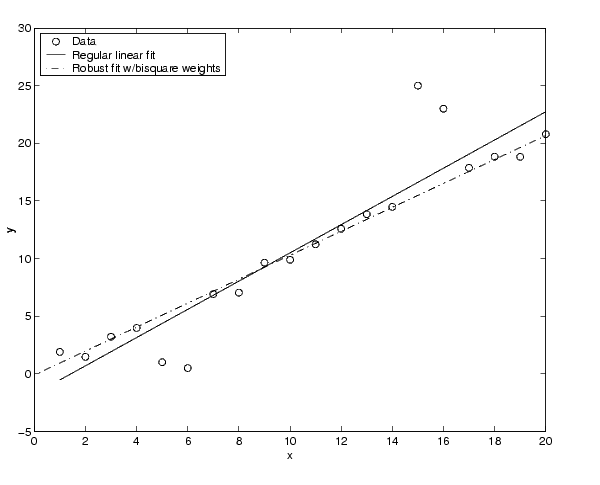

| Curve Fitting Toolbox |   |
The Least Squares Fitting Method
The Curve Fitting Toolbox uses the method of least squares when fitting data. The fitting process requires a model that relates the response data to the predictor data with one or more coefficients. The result of the fitting process is an estimate of the "true" but unknown coefficients of the model.
To obtain the coefficient estimates, the least squares method minimizes the summed square of residuals. The residual for the ith data point ri is defined as the difference between the observed response value yi and the fitted response value  , and is identified as the error associated with the data.
, and is identified as the error associated with the data.

The summed square of residuals is given by

where n is the number of data points included in the fit and S is the sum of squares error estimate. The supported types of least squares fitting include
Linear Least Squares
The Curve Fitting Toolbox uses the linear least squares method to fit a linear model to data. A linear model is defined as an equation that is linear in the coefficients. For example, polynomials are linear but Gaussians are not. To illustrate the linear least squares fitting process, suppose you have n data points that can be modeled by a first-degree polynomial.

To solve this equation for the unknown coefficients p1 and p2, you write S as a system of n simultaneous linear equations in two unknowns. If n is greater than the number of unknowns, then the system of equations is overdetermined.

Because the least squares fitting process minimizes the summed square of the residuals, the coefficients are determined by differentiating S with respect to each parameter, and setting the result equal to zero.

The estimates of the true parameters are usually represented by b. Substituting b1 and b2 for p1 and p2, the previous equations become

where the summations run from i =1 to n. The normal equations are defined as


Solving for b2 using the b1 value

As you can see, estimating the coefficients p1 and p2 requires only a few simple calculations. Extending this example to a higher degree polynomial is straightforward although a bit tedious. All that is required is an additional normal equation for each linear term added to the model.
In matrix form, linear models are given by the formula

 is a m-by-1 vector of coefficients.
is a m-by-1 vector of coefficients.
 is an n-by-1 vector of errors.
is an n-by-1 vector of errors.
For the first-degree polynomial, the n equations in two unknowns are expressed in terms of y, X, and  as
as

The least squares solution to the problem is a vector b, which estimates the unknown vector of coefficients  . The normal equations are given by
. The normal equations are given by

where XT is the transpose of the design matrix X. Solving for b,

In MATLAB, you can use the backslash operator to solve a system of simultaneous linear equations for unknown coefficients. Because inverting XTX can lead to unacceptable rounding errors, MATLAB uses QR decomposition with pivoting, which is a very stable algorithm numerically. Refer to Arithmetic Operators in the MATLAB documentation for more information about the backslash operator and QR decomposition.
You can plug b back into the model formula to get the predicted response values,  .
.

A hat (circumflex) over a letter denotes an estimate of a parameter or a prediction from a model. The projection matrix H is called the hat matrix, because it puts the hat on y.

Refer to [1] or [2] for a complete description of the matrix representation of least squares regression.
Weighted Linear Least Squares
As described in Basic Assumptions About the Error, it is usually assumed that the response data is of equal quality and, therefore, has constant variance. If this assumption is violated, your fit might be unduly influenced by data of poor quality. To improve the fit, you can use weighted least squares regression where an additional scale factor (the weight) is included in the fitting process. Weighted least squares regression minimizes the error estimate

where wi are the weights. The weights determine how much each response value influences the final parameter estimates. A high-quality data point influences the fit more than a low-quality data point. Weighting your data is recommended if the weights are known, or if there is justification that they follow a particular form.
The weights modify the expression for the parameter estimates b in the following way,

where W is given by the diagonal elements of the weight matrix w.
You can often determine whether the variances are not constant by fitting the data and plotting the residuals. In the plot shown below, the data contains replicate data of various quality and the fit is assumed to be correct. The poor quality data is revealed in the plot of residuals, which has a "funnel" shape where small predictor values yield a bigger scatter in the response values than large predictor values.

The weights you supply should transform the response variances to a constant value. If you know the variances of your data, then the weights are given by

If you don't know the variances, you can approximate the weights using an equation such as

This equation works well if your data set contains replicates. In this case, n is the number of sets of replicates. However, the weights can vary greatly. A better approach might be to plot the variances and fit the data using a sensible model. The form of the model is not very important -- a polynomial or power function works well in many cases.
Robust Least Squares
As described in Basic Assumptions About the Error, it is usually assumed that the response errors follow a normal distribution, and that extreme values are rare. Still, extreme values called outliers do occur.
The main disadvantage of least squares fitting is its sensitivity to outliers. Outliers have a large influence on the fit because squaring the residuals magnifies the effects of these extreme data points. To minimize the influence of outliers, you can fit your data using robust least squares regression. The toolbox provides these two robust regression schemes:
Robust fitting with bisquare weights uses an iteratively reweighted least squares algorithm, and follows this procedure:



The plot shown below compares a regular linear fit with a robust fit using bisquare weights. Notice that the robust fit follows the bulk of the data and is not strongly influenced by the outliers.

Instead of minimizing the effects of outliers by using robust regression, you can mark data points to be excluded from the fit. Refer to Excluding and Sectioning Data for more information.
Nonlinear Least Squares
The Curve Fitting Toolbox uses the nonlinear least squares formulation to fit a nonlinear model to data. A nonlinear model is defined as an equation that is nonlinear in the coefficients, or a combination of linear and nonlinear in the coefficients. For example, Gaussians, ratios of polynomials, and power functions are all nonlinear.
In matrix form, nonlinear models are given by the formula

 and X.
and X.
 is a m-by-1 vector of coefficients.
is a m-by-1 vector of coefficients.
 is an n-by-1 vector of errors.
is an n-by-1 vector of errors.
Nonlinear models are more difficult to fit than linear models because the coefficients cannot be estimated using simple matrix techniques. Instead, an iterative approach is required that follows these steps:
 is given by
is given by

You can use weights and robust fitting for nonlinear models, and the fitting process is modified accordingly.
Because of the nature of the approximation process, no algorithm is foolproof for all nonlinear models, data sets, and starting points. Therefore, if you do not achieve a reasonable fit using the default starting points, algorithm, and convergence criteria, you should experiment with different options. Refer to Specifying Fit Options for a description of how to modify the default options. Because nonlinear models can be particularly sensitive to the starting points, this should be the first fit option you modify.
 | Basic Assumptions About the Error | Library Models |  |